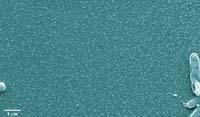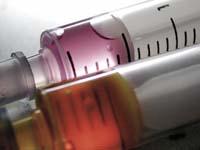Small friends against great diseases

The hydrogels are cross-linked polymers. These reticular structures swell in liquid but do not dissolve. This type of polymers are used for the manufacture of artificial muscles or for the extraction of heavy metals in water.
Issa A. The research group led by Dr. Katime is a pioneer in hydrogels research and is the only book published on this topic in Spanish. Currently, the use of hydrogels is being investigated for the controlled release of drugs, as in cases of cancer. On the one hand, in addition to transporting and releasing the drug, hydrogels capable of detecting cancer cells have been designed. To detect these cells, developed hydrogels are able to detect pH changes -- the blood has a pH of 7.4, but in cancer cells it descends to 4.7-5.2. Hydrogels with folic acid have been used to achieve this capacity. This acid is capable of detecting pH changes and misleading cancer cells. It works like a Trojan horse: when it is inside the cell, by pH swollen the hydrogel, releasing the drug.
On the other hand, conventional hydrogels presented a problem of use in patients: size. The best way to manage the drugs is to do it through the blood, which reaches all locations in a very short time, but it is not possible to inject very large molecules into the body, since they can cause obstructions, such as angina or cardiac portillo. For the human use of hydrogels it is necessary to create very small particles, small enough to avoid obstruction and that the white blood cells do not detect -- if they detect them, they would be attacked. Thus, if these particles are small enough to cross the membrane of the kidney, if no cancer cells are found, they can be eliminated by the urine.
Size problem
The work with nanoparticles used for this purpose presents difficulties such as controlled reticulation, in order to generate nanohydrogel, the fact that the gaps generated in the network structure have the necessary size to transport the drug, and that all nanoparticles have a similar size.
In fact, the size of the particles resulting from the synthesis of polymers is very different. If it is to inject into the human body, the size of the particles cannot be far from 15-30 nanometers, so they have developed a technique to obtain nanoparticles of the same size.

The design of nanoparticles has been successfully completed. To carry out the tests in vivo they collaborate with a team led by José María Teijo, of the Faculty of Medicine of the Complutense University of Madrid, and a group led by Antonio Quintana, of the Faculty of Medicine of the UPV.
These smart nanohydrogels are appropriate not only for cancer cases. The possibility of using anti-tuberculosis drugs with nanohydrogels is now being investigated. In fact, at present, the most effective drugs against tuberculosis should be injected several times a day. This can be a problem in areas with difficult access to health centers, such as underdeveloped areas.
The research team is developing nanohydrogels that release the anti-tuberculosis mixture of drugs in a controlled and constant manner for a long time. In this case, the nanohydrogel carries more than one substance, making it difficult to control the frequency and release concentration of drugs. This will force researchers to adapt the hydrogel structure to the needs of each case.






